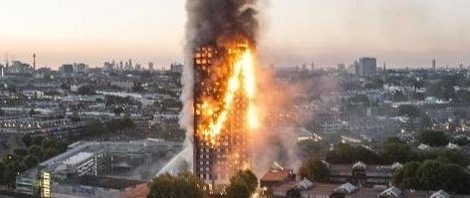Managing Fire Risk in the Workplace
- 15 June 2017
- Safety
- Comments : 0
How Should I Manage the Risk of Fire in My Workplace?
Yesterday there was a devastating fire in a London residential building, Grenfell Tower, which has claimed 17 lives*. That death toll will rise in the coming days. (* update: 71 deaths now confirmed)
In the cold hard light of day, a lot of organisations will be – and should be – thinking about whether they’re effectively protecting their people and their assets.
I’ve spent a lot of time working in high rise and low rise buildings, and in my Health & Safety role, I’ve been responsible for fire safety. Risks in residential buildings are different to those of commercial buildings. Today we’ll be discussing commercial buildings, where there is a legal dutyholder who is responsible for managing the risk of fire. With this in mind, we’re going to address the important question:
What steps should I take to reduce the risk of fire in my workplace?
Follow these simple to implement steps and you will significantly reduce the risk of fire in your workplace. But first, let’s review some of your legal requirements.
What does the law tell me I need to have / need to do?
- Fire Risk Assessment (more information below)
- Fire Policy
- Fire procedures such as fire evacuation
- Provide staff training – fire wardens, general staff training on induction and regular reminders
- Carry out fire evacuation drills
- Maintain clear means of escape, signs, notices, emergency lighting, fire detection and fire extinguishers
- Consult your employees on fire safety matters. You must tell people if the fire procedures change. Never assume that people will stop and read signs – or that they will be able to in a smoke filled building
5 steps to take to reduce or manage the risk of fire in your workplace
1. Have a Fire Risk Assessment (FRA) completed by a competent person
- The FRA must be suitable and sufficient
- It must be held on site, readily accessible at all times
- FRA must be kept up to date and reviewed regularly or when changes have been made such as the introduction of new equipment, upgrade to the fire alarm or sprinkler system
- The Fire Risk Assessor / Auditor must be competent
SAWT PRO TIP: It is a good idea to accompany your auditor throughout the audit. This is an excellent learning experience for those accompanying the auditor, plus you’ll understand the list of actions that result from the audit as you saw the issues yourself
2. Ensure that your active fire detection is functioning
- We regularly see smoke detectors that have been compromised e.g. left covered up after building works have finished
- You must always conduct a visual inspection after contractor works have completed and before you sign them off
3. Check your emergency staircases are completely clear
- It’s extremely dangerous to have combustibles kept in staircases. The last thing you want is your route to safety being compromised
4. Check that sprinkler systems are able to fully function
- It is essential that partitioning etc does not interfere with sprinkler heads. Contractor works should always be checked after completion to ensure things like this don’t happen…
5. Produce audit reports – especially for Fire Risk Assessments
- Your audits and assessments should be living, breathing documents. There’s little worse than arriving on site after a fire incident and discovering a pristine FRA. I love seeing an FRA with dog-eared pages and handwritten notes updating progress on outstanding items
- Make notes in pen, sign the item off when complete and date it
- If your audits are kept in a database or online, you must ensure that updates are made within that system
- These things go a long way to showing that you are taking your risks seriously, and that you’ve been taking steps to manage and reduce those risks
If I wanted to learn more what should I read?
- HSE’s fire and explosion home page
- Controlling Fire and Explosion in the Workplace
- Regulatory Reform (Fire Safety) Order 2005 summary
Managing the risk of fire in your workplace is absolutely essential. As we’ve seen this week, catastrophes happen, and they can happen quickly. If you’ve not done everything you should to protect your people, it is quite possible that people could lose their lives in a fire.
Apart from the guilt you’d feel for the rest of your life, there’s a good chance you’ll end up in prison after a Corporate Manslaughter prosecution. We all need to take fire risk extremely seriously.




